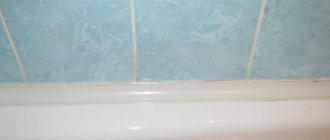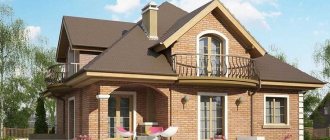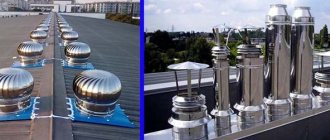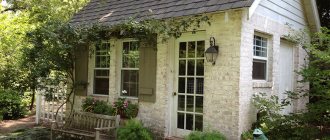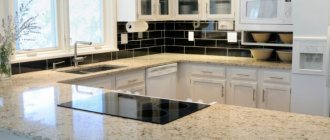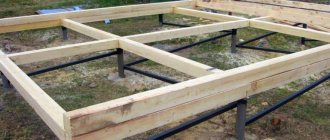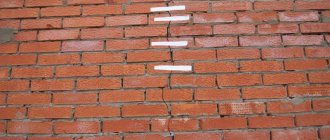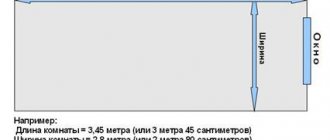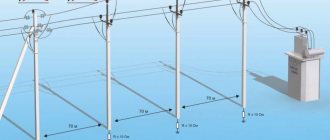A large article about the theory of ventilation and air gaps. Recently, questions on this topic have become more frequent. It is believed that a ventilation or air gap can retain heat and improve the performance of the wall. Here is my opinion on this topic
Dmitry Belkin
Author: Dmitry Belkin
In this article I will consider the issues of ventilation of the inter-wall space and the connection between this ventilation and insulation. In particular, I would like to understand why a ventilation gap is needed, how it differs from an air gap, what its functions are, and whether a gap in the wall can perform a thermal insulation function. This issue has become quite relevant lately and causes many misunderstandings and questions. Here I give my private expert opinion, based only on personal experience and nothing else.
Denial of responsibility
Having already written the article and re-reading it again, I see that the processes occurring during the ventilation of the inter-wall space are much more complex and multifaceted than I described. But I decided to leave it like this, in a simplified version. Particularly meticulous citizens, please write comments. We will complicate the description as we work.
The essence of the problem (subject part)
Let's understand the subject matter and agree on terms, otherwise it may turn out that we are talking about one thing, but mean completely opposite things.
Wall
This is our main subject. The wall can be uniform, for example, brick, or wood, or foam concrete, or cast. But a wall can also consist of several layers. For example, the wall itself (brickwork), a layer of insulation-thermal insulator, a layer of external finishing.
Air gap
This is the wall layer. Most often it is technological. It turns out by itself, and without it it is either impossible to build our wall, or it is very difficult to do it. An example is an additional wall element such as a leveling frame.
Example
Let's assume we have a newly built wooden house. We want to finish him off. First of all, we apply the rule and make sure that the wall is curved. Moreover, if you look at the house from a distance, you see a quite decent house, but when you apply the rule to the wall, it becomes clear that the wall is horribly crooked. Well... there's nothing you can do! This happens with wooden houses. We level the wall with a frame. As a result, a space filled with air is formed between the wall and the external decoration. Otherwise, without a frame, it will not be possible to make a decent exterior decoration of our house - the corners will “disintegrate.” As a result, we get an air gap.
Let us remember this important feature of the term under consideration.
Ventilation gap
This is also a layer of the wall. It looks like an air gap, but it has a purpose. Specifically, it is designed for ventilation. In the context of this article, ventilation is a series of measures aimed at removing moisture from the wall and keeping it dry. Could this layer combine the technological properties of an air gap? Yes, maybe that’s what this article is being written about, in essence.
When is a ventilation gap not needed?
In what cases can a ventilation gap be omitted:
- The material of the walls of the house does not allow steam to pass from the interior to the outside, for example, concrete.
- The insulation on the interior side is well insulated with a vapor barrier.
- External material allows steam to pass through well, for example, facade plaster.
The wet facade system is built on this ability of facade plaster, when the walls can be insulated with foam plastic or basalt wool.
Any vapor that gets into the insulation is released directly through the plaster layer and vapor-permeable paint. In this case, there is no ventilation gap between the insulation and the decorative layer.
Physics of processes inside the wall
Condensation
Why dry the wall? Is she getting wet or what? Yes, it gets wet. And you don't need to hose it down to get it wet. The temperature difference from the heat of the day to the coolness of the night is quite enough. The problem of getting the wall, all its layers, wet as a result of moisture condensation might be irrelevant in a frosty winter, but here the heating of our house comes into play. As a result of the fact that we heat our houses, warm air tends to leave the warm room and moisture condensation occurs again in the thickness of the wall. Thus, the relevance of drying the wall remains at any time of the year.
Convection
Please note that the site has a good article about the theory of condensation in walls
Warm air tends to rise and cold air tends to sink. And this is very unfortunate, since in our apartments and houses we live not on the ceiling, where warm air collects, but on the floor, where cold air collects. But I seem to have gotten distracted.
It is impossible to completely get rid of convection. And this is also very unfortunate.
But let's look at a very useful question. How does convection in a wide gap differ from the same convection in a narrow gap? We have already understood that the air in the gap moves in two directions. On a warm surface it moves up, and on a cold surface it goes down. And this is where I want to ask a question. What happens in the middle of our gap? And the answer to this question is quite complicated. I believe that the layer of air directly at the surface moves as quickly as possible. It pulls along layers of air that are nearby. As far as I understand, this happens due to friction. But the friction in the air is quite weak, so the movement of neighboring layers is much less fast than the “wall” ones. But there is still a place where the air moving up comes into contact with the air moving down. Apparently in this place, where multidirectional flows meet, something like turbulence occurs. The lower the flow speed, the weaker the turbulence. If the gap is wide enough, these swirls may be completely absent or completely invisible.
But what if our gap is 20 or 30 mm? Then the turbulence can be stronger. These vortices will not only mix the flows, but also slow down each other. It seems that if you make an air gap, you should strive to make it thinner. Then two differently directed convection flows will interfere with each other. And that's what we need.
Difficulties
Considering the presence of unevenness in the surface of the supporting structure, the distance between it and the facing masonry without insulation usually exceeds the maximum permissible values and is 3-5 cm. And the problems of three-layer masonry are low air permeability and the accumulation of condensate inside the layers of the structure in the cold season, which limits the period service of the heat-insulating layer. But the main disadvantage is the impossibility of replacing it.
Feedback form
Your request has been sent successfully!
Thank you for your request! We will contact you shortly.
Let's look at some funny examples.
First example
Let us have a wall with an air gap. The gap is blank. The air in this gap has no connection with the air outside the gap. On one side of the wall it is warm, on the other it is cold. Ultimately, this means that the inner sides of our gap also differ in temperature in the same way. What happens in the gap? The air in the gap rises along the warm surface. When it's cold it goes down. Since this is the same air, a cycle is formed. During this cycle, heat is actively transferred from one surface to another. And actively. This means that it is strong. Question. Does our air gap perform a useful function? Looks like no. It looks like it is actively cooling the walls for us. Is there anything useful in this air gap of ours? No. There doesn't seem to be anything useful in it. Basically and forever and ever.
Second example.
Suppose we made holes at the top and bottom so that the air in the gap communicates with the outside world. What has changed for us? And the fact is that now there seems to be no cycle. Either it is there, but there is also air leaking and venting. Now the air is heated from the warm surface and, perhaps partially, flies out (warm), and cold air from the street takes its place from below. Is it good or bad? Is it very different from the first example? At first glance it gets even worse. The heat goes outside.
I will note the following. Yes, now we are heating the atmosphere, but in the first example we were heating the casing. How much is the first option worse or better than the second? You know, I think these are approximately the same options in terms of their harmfulness. My intuition tells me this, so, just in case, I don’t insist that I’m right. But in this second example we got one useful function. Now our gap has become an air ventilation gap, that is, we have added the function of removing moist air, and therefore drying the walls.
Is there convection in the ventilation gap or does the air move in one direction?
Of course have! In the same way, warm air moves up and cold air moves down. It's just not always the same air. And there is also harm from convection. Therefore, the ventilation gap, just like the air gap, does not need to be made wide. We don't need wind in the ventilation gap!
What's good about drying a wall?
Above, I called the process of heat transfer in the air gap active. By analogy, I will call the process of heat transfer inside the wall passive. Well, maybe this classification is not too strict, but the article is mine, and in it I have the right to such outrages. So here it is. A dry wall has a much lower thermal conductivity than a damp wall. As a result, heat will reach the harmful air gap more slowly from inside the warm room and will also be less carried outside. Simply, convection will slow down, since the left surface of our gap will no longer be so warm. The physics of the increase in thermal conductivity of a damp wall is that vapor molecules transfer more energy when colliding with each other and with air molecules than just air molecules colliding with each other.
Facing aerated concrete with bricks: the correct ways to finish aerated concrete walls
Exterior decoration of houses made of aerated concrete blocks with bricks is very popular these days. A building that is erected from this material and then covered with brickwork is much cheaper than a completely brick building, while the appearance becomes modern, more aesthetic and high-status with the least investment. But is it just a matter of external attractiveness?
Advantages and disadvantages of cladding an aerated concrete wall with bricks
Let's take a closer look at the advantages and disadvantages of facing aerated concrete with bricks.
Advantages
- Soundproofing.
- Visual aesthetics.
- Strengthening the structure.
- Extension of service life.
Flaws
- If the installation is done incorrectly, condensation may accumulate in the wall cavity.
- Additional costs for construction and materials.
An expense item is expected in any case when lining a building, while aerated concrete blocks are one of the most inexpensive and sustainable structures. As reported by “Engineering and Construction Magazine” No. 8 (2009), after carrying out serious tests on the strength and durability of an aerated concrete wall with brick cladding in 2009 in St. Petersburg, it turned out that the lifespan of such a wall varies from 60 to 110 years or more. A single climate zone and material of equal quality were considered.
A house made of aerated concrete, lined with brick, can have a service life that varies by almost half.
Why is there such a difference in strength and wear resistance? It turned out that the problem was the presence of a gap and ventilation between the base of aerated blocks and the brick cladding.
What are the methods for facing aerated concrete blocks with bricks?
A gas block wall can be covered in several ways. This refers to the distance between the brick and the aerated concrete block, as well as the presence of insulation, if there is a gap between the wall and the cladding. Let's look at each of them in detail.
Dense masonry without gaps and ventilation
The danger of rapid destruction appears when it is planned to use a heated room. That is, the difference in temperatures inside and outside the house will significantly reduce the service life of such a building. When the room is heated from the inside, water vapor will begin to move out through the porous aerated concrete. If there is no gap or insulation, they will accumulate between the gas block and the brick, destroying both materials. In this case, condensate accumulates unevenly, which accelerates the process of decay and deformation of the structure of the gas block. The most cost-effective option would be to use external insulation in the form of mineral wool or wet plaster finishing. A similar finishing of aerated concrete with bricks (without a gap) is applied only to unheated buildings.
How does the wall ventilation process work?
Well, it's simple. Moisture appears on the surface of the wall. The air moves along the wall and carries away moisture from it. The faster the air moves, the faster the wall dries out if it is wet. It's simple. But it gets more interesting.
What wall ventilation rate do we need? This is one of the key questions of the article. By answering it, we will understand a lot about the principle of constructing ventilation gaps. Since we are not dealing with water, but with steam, and the latter is most often just warm air, we need to remove this warm air from the wall. But by removing warm air, we cool the wall. In order not to cool the wall, we need such ventilation, such a speed of air movement at which the steam would be removed, but a lot of heat would not be taken away from the wall. Unfortunately, I cannot say how many cubes per hour should pass along our wall. But I can imagine that it’s not a lot at all. A certain compromise is needed between the benefits of ventilation and the harm from heat removal.
When exactly is a ventilation gap needed?
So, in your case, a ventilated gap between the insulation and the outer decorative layer will definitely be needed in the following cases:
- The use of any insulation that loses its properties when wet.
- The material of the walls of the house allows steam to pass from the interior to the outer layer.
- Decorative finishing is a layer of vapor barrier or moisture-condensing material.
The last point can fully be attributed to vinyl siding, metal siding and profiled sheets. These materials will not allow moisture to escape from the insulation if they are tightly sewn onto the insulation layer.
Interim conclusions
The time has come to sum up some results, without which we would not want to move on.
There is nothing good about an air gap.
Yes indeed. As shown above, a simple air gap does not provide any useful function. This should mean it should be avoided. But I have always been kind to the phenomenon of an air gap. Why? As always, for a number of reasons. And, by the way, I can justify each one.
Firstly, the air gap is a technological phenomenon and it is simply impossible to do without it.
Secondly, if I can’t do it, then why should I unnecessarily intimidate honest citizens?
And thirdly, damage from the air gap does not rank first in the ranking of damage to thermal conductivity and construction mistakes.
But please remember the following to avoid future misunderstandings. An air gap can never, under any circumstances, serve to reduce the thermal conductivity of a wall. That is, the air gap cannot make the wall warmer.
And if you are going to make a gap, then you need to make it narrower, not wider. Then the convection currents will interfere with each other.
The ventilation gap has only one useful function.
This is true and it's a shame. But this single function is extremely, simply vitally important. Moreover, it is simply impossible to live without it. In addition, we will next consider options for reducing harm from air and ventilation gaps while maintaining the positive functions of the latter.
A ventilation gap, as opposed to an air gap, can improve the thermal conductivity of the wall. But not due to the fact that the air in it has low thermal conductivity, but due to the fact that the main wall or thermal insulation layer becomes drier.
Is a ventilation gap always necessary?
A question about house cladding is asked by Arkady Karpov, Moscow: Hello, I want to ask you a question.
Now a team is doing the sheathing of my house, insulating it and covering it with siding. After laying the film, siding is immediately sewn on top of it. I say – where is the gap? They say no need, we always do this. Are they doing the right thing and doing it the right way? Answered by Andrey Volokolamtsev, foreman of Avgust LLC, Podolsk.
Hello, Arkady. Perhaps what your builders are doing is not entirely correct, or perhaps it is not at all correct. So that you have a normal and systematic understanding of this issue, let’s first look at your case, and then see if a ventilation gap needs to be done and when.
So, let's figure out what material your house is made of. If the walls are made of vapor-permeable material, then if you use a decorative layer of siding, you must make a ventilated gap. Because moisture from the interior of your home in the form of steam will penetrate through the walls into the insulation and moisten it.
Insulation materials such as basalt wool do not like moisture very much. When they get wet by at least 15 percent, they already lose 50 percent in their thermal resistance.
There are, however, insulation materials that are not so susceptible to moisture and that do not lose their heat-insulating ability as much. This primarily applies to polyurethane foam, which can be sprayed onto the walls of a house.
How to reduce damage from air convection in the ventilation gap?
Obviously, to reduce convection means to prevent it. As we have already found out, we can prevent convection by colliding two convection currents. That is, make the ventilation gap very narrow. But we can also fill this gap with something that would not stop convection, but would significantly slow it down. What could it be?
Foam concrete or gas silicate? By the way, foam concrete and gas silicate are quite porous and I am ready to believe that there is weak convection in a block of these materials. On the other hand, our wall is high. It can be 3 or 7 meters or more in height. The greater the distance the air has to travel, the more porous the material we must have. Most likely, foam concrete and gas silicate are not suitable.
Moreover, wood, ceramic brick, and so on are not suitable.
Styrofoam? Not! Polystyrene foam is also not suitable. It is not too easily permeable to water vapor, especially if it needs to travel more than three meters.
Bulk materials? Like expanded clay? Here, by the way, is an interesting proposal. It could probably work, but expanded clay is too inconvenient to use. It gets dusty, wakes up and all that.
Low density wool? Yes. I think very low density wool is the leader for our purposes. But the cotton wool is not produced in a very thin layer. You can find canvases and slabs at least 5 cm thick.
As practice shows, all these arguments are good and useful only in theoretical terms. In real life, you can act much simpler and more prosaically, which I will write about in a pathetic way in the next section.
Is the ventilation box a cold bridge?
The ventilation box cannot be a cold bridge. The ventilation box is mounted in the body of the facing brickwork and does not in any way disrupt the continuity of thermal insulation (the facing brickwork in multi-layer walls freezes and does not perform a heat-insulating function). As a rule, in three-layer or two-layer walls, where the facade is faced with facing or clinker bricks, the cold bridge is galvanized anchors or masonry mesh, acting as horizontal connections.
Forgot to make a ventilation gap in an external wall made of blocks and bricks: what to do?
Hello! I wanted to ask the following question: basalt andesite block 40 cm, basalite 75 density 10 cm, facing brick. Later it turned out that there was no ventilation gap. What to do? House on 2 floors.
Alas, we are not aware of methods for radically changing the design of an already built permanent wall without large financial expenditures.
In our opinion, you have three options: “right” (expensive), “wrong” (free) and “rational” (also expensive):
Option #1: “correct”
Completely dismantle the facing brickwork and add foundation to the building from the outside, if necessary. Fix basalt wool (basalite) to the wall with dowels for insulation (fungi), build a new cladding, not forgetting to leave a ventilation gap 40-60 mm wide. Connect blocks and bricks together. In the brick cladding, leave openings for ventilation in the upper and lower parts of the wall measuring 100x100 mm with a horizontal step of at least 2.5 m, covering them with fine mesh grilles to prevent the penetration of rodents and wasps. This is the “correct” solution, very labor-intensive and expensive.
Option #2: “wrong”
Let it be as it is. Accept that the efficiency of basalt insulation will seriously drop by 20-70% depending on the operating mode of the building and the humidity of the outside air. The service life of wall blocks will decrease slightly (approximately 5-10%). But no investment.
Option #3: “rational”
If you decide that option No. 2 does not suit you due to the loss of the planned thermal characteristics of the wall, and No. 1 because of the scale of the work, consider insulating the house with hard mineral wool from the outside. In terms of costs, this will be comparable to option No. 1, but the result will be better: the wall is warmer, the work time is much shorter.
You may also be advised to insulate the walls from moisture entering them from inside the building by installing a vapor barrier. We do not recommend it; it will worsen the microclimate in the house, but will not completely solve the problem.
Is there a need for internal insulation?
They mainly talk about insulating walls made of gas silicate blocks from the outside. But you can potentially insulate a house from the cold from the inside.
It is important to understand that in this case you will have to put up with the following points:
- a portion of the usable area will be lost;
- it will be necessary to provide an additional ventilation system;
- the dew point moves inward;
- indoor humidity will increase;
- the risk of mold and mildew will increase.
If you think that this is not so critical, then no one will forbid you to carry out insulation.
Dimensions and requirements
The basic standards for ventilation gaps in brick walls are regulated by SNIP. According to these documents, the size of the gap is 1.5-2 cm. But practice shows that unevenness and defects of the wall surface do not fit within this framework. Therefore, the actual ventilation gap is 3-5 cm. Air should pass through the air cushion unhindered. Brick laying is carried out in such a way as to ensure ventilation, in which moisture is displaced through the upper hole by a flow of air penetrating through the lower gap, measuring 10 * 10 cm. The holes are placed horizontally with a range of 2.5 m.
To prevent insects and rodents from entering through these holes, fine mesh grilles are installed on them.
